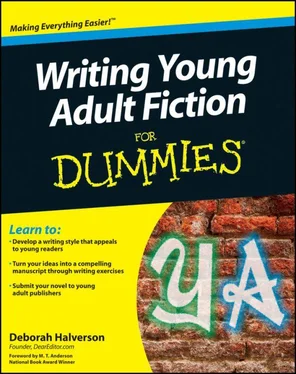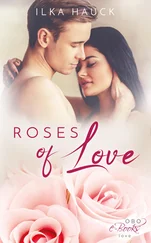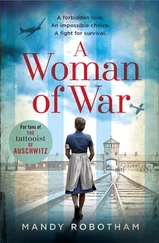1 ...6 7 8 10 11 12 ...121 As young people’s emotions, intellect, and interests change, a writer’s word choice and sentence structure may become more complex, as may the plot. Chapter 9 focuses on the language techniques that allow you to adjust your storytelling for your chosen age group. Chapter 7 is where you shape your plot for the specific audience you identify here.
 Understanding what’s suited to tween or teen sophistication and what would be better aimed at an older audience is important. YALSA (the Young Adult Library Services Association) offers many booklists among their public resources that can help illuminate the genres, themes, and categories of young adult fiction for you — visit www.ala.org/yalsa. But don’t just read the titles on those lists; read the books themselves. Lots of them. That’s the only way to get a solid feel for your genre, your target audience, and the current book market. How’s that for fun homework?
Understanding what’s suited to tween or teen sophistication and what would be better aimed at an older audience is important. YALSA (the Young Adult Library Services Association) offers many booklists among their public resources that can help illuminate the genres, themes, and categories of young adult fiction for you — visit www.ala.org/yalsa. But don’t just read the titles on those lists; read the books themselves. Lots of them. That’s the only way to get a solid feel for your genre, your target audience, and the current book market. How’s that for fun homework?
Targeting gender
Publishers are unabashedly vocal about their desire to reel in boy readers, especially boy tweens. Those fellas are a consistently hard-to-reach audience, and it drives book-lovers crazy. Who doesn’t want boys to read for fun? Many boys already do, certainly, but not nearly in the numbers that girls do or with the frequency.
Studies give all sorts of reasons for boys’ reluctance to read, from the fact that boys are slower to develop and thus their reading skills aren’t as advanced as girls’ to the belief that boys are uncomfortable exploring emotions in books, instead preferring gnarly explosions. In other words, boys are drawn to the action that’s so easily had in video games, TV, and movies. You have to wrest boys away from these things to free up their eyes for a book.
If you want to target boys, bait your line with a theme or topic tempting enough to set aside their game controllers for. Many writers find success by offering action fare along with irreverence, silly humor, and sports themes while slipping the emotional stuff underneath. My novel Big Mouth , for example, is about a 14-year-old boy training to be a competitive eater — with the goal of eating 54 hot dogs (and buns!) in the time it takes the rest of us to tuck our napkins into our shirts. But under that gastric “sports story” lurks the issue of eating disorders in teen boys. Walter Dean Myers’s Hoops is an example of not shying away from the hard stuff, coming at boys full-force even as he ensconces his drama in the boy-friendly world of basketball.
Chapter books: Sooo not YA fiction
Writers new to the children’s book world often get confused about chapter books and novels, wrongly seeing chapter books as young middle grade novels. They’re not. They fall squarely in the children’s book category, alongside picture books.
Aimed at ages 6–9 or 7–10 (first through fourth grade), chapter books are a transition from beginning readers to MG novels, offering young readers experience with longer narratives and with following plot and character development across multiple chapters. These books have fully developed chapters and are roughly 100 or more pages, although those pages usually include some illustrations and decorative elements — hence their children’s-book categorization. The short chapters work well for short attention spans, and the slightly larger print keeps the books from intimidating budding independent readers. Some chapter books, like the Geronimo Stilton series, graphically enhance the text itself with funky fonts and colors to keep the text blocks welcoming. The story sophistication level is well below that of MG and YA.
The chapter book market is dominated by series, often with a main-character-and-his-sidekick formula. Familiar characters, familiar author style, and familiar themes make readers loyal to their series and stretch the series’ appeal to reluctant readers — which means they get a lot of boy readers (hurrah!). Popular examples include Bruce Hale’s Chet Gecko series, Barbara Park’s Junie B. Jones series, Jon Scieszka’s Time Warp Trio series, and Donald J. Sobol’s classic Encyclopedia Brown series.
Just below chapter books are the “intermediate reader” or “transitional reader” chapter books, such as Mary Pope Osborne’s Magic Tree House books. These books have chapters, yes, but they’re even shorter than chapter books, making them great reads for children who are just venturing into independent reading.
 For more about boys and reading, visit the website of Guys Read (www.guysread.com), a nonprofit literacy program for boys and men that was founded by Jon Scieszka, the Library of Congress’s first National Ambassador for Young People’s Literature.
For more about boys and reading, visit the website of Guys Read (www.guysread.com), a nonprofit literacy program for boys and men that was founded by Jon Scieszka, the Library of Congress’s first National Ambassador for Young People’s Literature.
Of course, boys aren’t the only gender-specific audience you can write for. See the later section “Exploring common genres” for info on chick lit and other gender-related genres.
Exercise: Name your category
 To ensure that you develop a story that syncs with the needs, intellect, and emotional sophistication of a single audience, get a clear bead on your category and age range early on. You don’t want to discover at the end of draft one that the topic or theme of the story you so meticulously crafted for older readers is actually more suited to middle graders. Answer the following questions to help you define your category and age range before you start crafting the narrative:
To ensure that you develop a story that syncs with the needs, intellect, and emotional sophistication of a single audience, get a clear bead on your category and age range early on. You don’t want to discover at the end of draft one that the topic or theme of the story you so meticulously crafted for older readers is actually more suited to middle graders. Answer the following questions to help you define your category and age range before you start crafting the narrative:
 Will the characters be worried about how the outcome affects them or how it affects others?Middle graders are focused inward, and older teens start to look outward. The more mature and empathetic your character, the older he’s likely to be — and thus the older your readership is likely to be.
Will the characters be worried about how the outcome affects them or how it affects others?Middle graders are focused inward, and older teens start to look outward. The more mature and empathetic your character, the older he’s likely to be — and thus the older your readership is likely to be.
 Will your plot involve age- or grade-related events such as getting a drivers’ license or passing the SAT?Know the developmental milestones that will be at play in your novel and sync them with your audience.
Will your plot involve age- or grade-related events such as getting a drivers’ license or passing the SAT?Know the developmental milestones that will be at play in your novel and sync them with your audience.
 Will there be violence?Generally, the more violence there is, the higher the target age range.
Will there be violence?Generally, the more violence there is, the higher the target age range.
 Will your theme be an edgy one?Older readers prefer riskier, rawer themes such as addiction or sexual experimentation; younger audiences are still getting their sea legs with the basic issues of puberty. You can find a list of potential themes later in “Looking at universal teen themes.”
Will your theme be an edgy one?Older readers prefer riskier, rawer themes such as addiction or sexual experimentation; younger audiences are still getting their sea legs with the basic issues of puberty. You can find a list of potential themes later in “Looking at universal teen themes.”
 To whom is the theme of most interest and value?Older teens like topics that make them think bigger than they currently do or that make them question themselves more deeply. Young readers tend to keep their focus a little closer to home.
To whom is the theme of most interest and value?Older teens like topics that make them think bigger than they currently do or that make them question themselves more deeply. Young readers tend to keep their focus a little closer to home.
Knowing Your Genre
Just because your novel is young adult fiction doesn’t mean every young adult will like it. As with grown-up readers, young people develop preferences for certain types of stories. They may love sweet romantic stories, or they may like funny ones, or they may like ogres and wizards and the heroic lads who thwart them. The types of stories in the young adult fiction category — its genres — are gloriously plentiful.
Читать дальше
Конец ознакомительного отрывка
Купить книгу

 Understanding what’s suited to tween or teen sophistication and what would be better aimed at an older audience is important. YALSA (the Young Adult Library Services Association) offers many booklists among their public resources that can help illuminate the genres, themes, and categories of young adult fiction for you — visit www.ala.org/yalsa. But don’t just read the titles on those lists; read the books themselves. Lots of them. That’s the only way to get a solid feel for your genre, your target audience, and the current book market. How’s that for fun homework?
Understanding what’s suited to tween or teen sophistication and what would be better aimed at an older audience is important. YALSA (the Young Adult Library Services Association) offers many booklists among their public resources that can help illuminate the genres, themes, and categories of young adult fiction for you — visit www.ala.org/yalsa. But don’t just read the titles on those lists; read the books themselves. Lots of them. That’s the only way to get a solid feel for your genre, your target audience, and the current book market. How’s that for fun homework? To ensure that you develop a story that syncs with the needs, intellect, and emotional sophistication of a single audience, get a clear bead on your category and age range early on. You don’t want to discover at the end of draft one that the topic or theme of the story you so meticulously crafted for older readers is actually more suited to middle graders. Answer the following questions to help you define your category and age range before you start crafting the narrative:
To ensure that you develop a story that syncs with the needs, intellect, and emotional sophistication of a single audience, get a clear bead on your category and age range early on. You don’t want to discover at the end of draft one that the topic or theme of the story you so meticulously crafted for older readers is actually more suited to middle graders. Answer the following questions to help you define your category and age range before you start crafting the narrative: Will the characters be worried about how the outcome affects them or how it affects others?Middle graders are focused inward, and older teens start to look outward. The more mature and empathetic your character, the older he’s likely to be — and thus the older your readership is likely to be.
Will the characters be worried about how the outcome affects them or how it affects others?Middle graders are focused inward, and older teens start to look outward. The more mature and empathetic your character, the older he’s likely to be — and thus the older your readership is likely to be.










